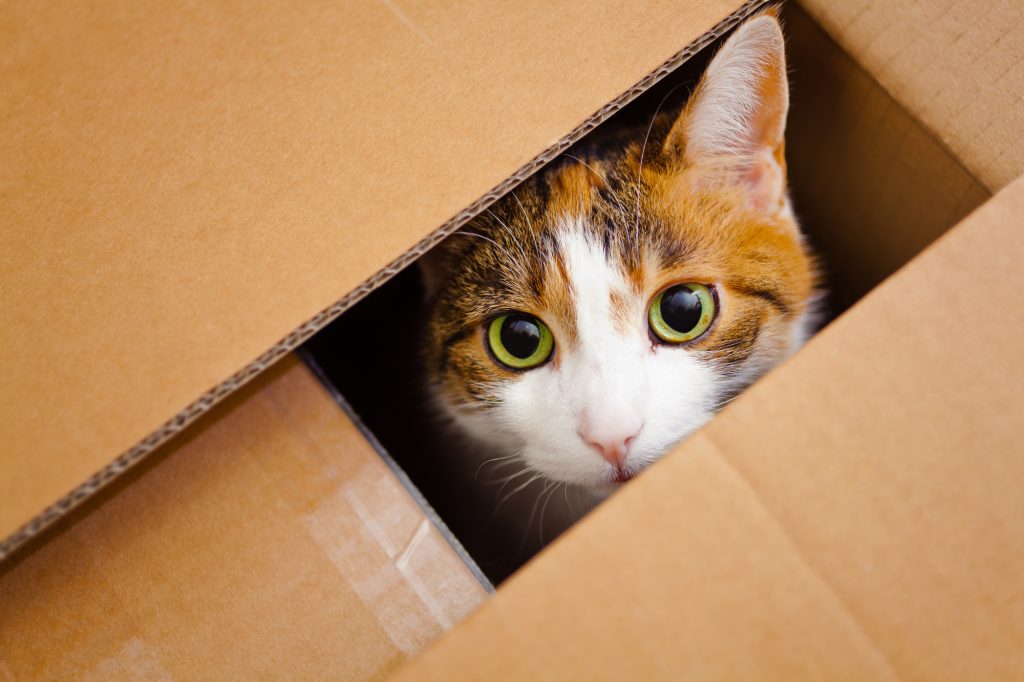Have you ever come in the room only to find your cat chewing on cardboard or paper? Many cat owners wonder why does my cat eat paper and cardboard?
This article will explain whether this behavior is normal, if you should be worried about this behavior, the risks of letting your cat eat paper or cardboard, as well as how to reduce this behavior.
Why Does My Cat Eat Paper and Cardboard?
It is actually very common for a cat to like to eat paper and cardboard. Chewing and eating cardboard can be a sign of hunger, boredom, teething, OCD, or in some cases an underlying medical condition.
Reasons Why Cats Like to Eat Paper and Cardboard
Cats tend to have a love for paper products. Although eating paper products is normal among cats, many cat owners want to understand the reasons as to why their cat exhibits this behavior.
Here are some possible explanations:
Your cat is teething
Just like human babies chew their toys to ease teething pain, kittens will do the same.
For kittens, teething occurs sometime between 10 weeks to 6 months of age. By the time they turn 6-7 months, all of their baby teeth will have fallen out and been replaced by 30 big adult cat teeth.
During this period, kittens may chew on anything they can get their mouth on, which includes paper and cardboard boxes! They do this because it helps ease the feeling of irritation in their gums.
If your cat is in this teething stage, there are plenty of teething toys for cats that can help alleviate some of their pain and discomfort that could lead to them to want to chew on other items.
Your cat has OCD
Some cats eat cardboard and paper because they have obsessive-compulsive disorder. Many people don’t realize that pets like dogs and cats can have OCD just like humans do.
It is not uncommon for a cat to engage in repetitive actions as a way of soothing themselves or coping with certain stressors. Keep an eye on the situations surrounding when your cat starts to eat paper and cardboard, you may be able to drill down to what is triggering it.
Your cat has a dental issue
If your cat chews on cardboard or paper outside of the teething age, your cat could have a dental issue.
Some cats develop dental problems as young as the age of 4. The most common dental problems are periodontitis, tooth resorption, and gingivitis. To soothe their gums from any pain caused by these dental issues, cats often look for something to chew on.
To avoid dental diseases, it is best to make sure your cat has proper toys to chew on and that your regularly brush your cat’s teeth. You should also have your vet check their teeth at their annual checkup, and some cats may need a professional dental cleaning from time to time as well.
Here are some common signs your cat may have a dental disease
- Visible tartar and/or tooth discoloration
- Bad breath
- Constant drooling
- Swollen or bleeding gums
- Pawing at the teeth or mouth
Additionally, it is also a good idea to regularly check inside your cat’s mouth to make sure nothing strange is going on it there. When you look inside their mouth, you are making sure their gums are their normal color and aren’t swollen, that there isn’t any bleeding, and that there are no missing or chipped teeth.
Your cat is bored, lonely, or anxious
Many vets and cat owners believe that cats chew, eat, or tear up cardboard boxes because they’re bored, anxious or lonely.
For many pets, boredom usually leads to destructive behaviors. If your cat has nothing else to do, they may end up chewing on items that aren’t food such as furniture, cardboard and paper.

The same goes for when your cat is lonely or anxious. Although cats can sometimes be aloof, it is still important to spend quality time with them daily and give them the appropriate toys to play with. Having enough attention from you will reduce their chances of getting lonely and anxious.
Your cat has PICA
PICA is a condition that causes cats to want to eat items that aren’t food. Most commonly, cats with PICA will like to eat cardboard, paper, fabric, and even plastic. If you cat gravitates toward eating weird items, you may want to see if your cat has PICA.
Your cat has a deficiency
Another common reason why cats chew/eat nonfood items like paper or cardboard is that they aren’t getting everything their body needs nutritionally. Make sure you are feeding your cat high-quality cat food that meets all their dietary requirements.
Dangers of Letting Your Cat Eat Paper and Cardboard
Eating small bits of shredded paper and cardboard doesn’t usually pose immediate harm to cats. However, if your cat eats too much of these items, or larger pieces of cardboard it could become more dangerous.
One of the biggest risks is that when a cat ingests larger pieces of non-food items, there’s a higher possibility that they’ll experience intestinal blockages.
Eating items that aren’t meant to be digested can cause a blockage internally since it can’t be broken down by your cat’s body in the same way that food would.
Monitor your cat to make sure that they aren’t swallowing pieces of cardboard or plastic that could be too large to work its way through their digestive system. If you suspect your cat has a blockage, take your cat to the vet immediately!
Ways to Stop Your Cat From Eating Paper and Cardboard
The good news is there are things you can do to try and help reduce the amount of paper and cardboard your cat eats. Here are some tips you can try:
Distract them when they want to chew
If you see your cat starting to chew on paper or cardboard, engage them in another activity. Pull out their favorite toy or something else to lure them away from the object they want to chew.
Provide your cat with many other fun things to do
Sometimes cats chew on things because they are bored. Make sure that you spend time with your cat to keep them from getting too bored and lonely. Also buy them mentally engaging toys, puzzle feeders, and scratching posts to help keep them occupied when you are busy.
Provide your cat with a healthy diet
Some cats eat paper and cardboard because of a nutritional deficiency. Make sure your cat is getting a balanced healthy diet that isn’t lacking in any key nutrients. Normally, your vet will be able to recommend some good cat food options that will provide your cat with all their body needs.
Make sure paper or cardboard are NOT easily accessible
The easiest way to keep your cat from eating these things is to keep them out of reach. If your cat can’t get to the paper or cardboard, they won’t be able to eat it!
Get a veterinary assessment
If cardboard eating persists, it’s best to have your cat checked out by a veterinarian just to make sure there isn’t an underlying medical issue.
Conclusion
Cats love to shred, nibble, and eat paper and cardboard. If you’ve noticed your cat doing it once in a while, it is likely nothing to worry about as this is a common cat behavior.
However, if your cat starts eating cardboard or paper more frequently, look at what is going on when they start exhibiting this behavior and you will likely be able to drill down to the reason why.
If you can’t figure it out, and you are concerned, it never hurts to make an appointment with the vet just to make sure everything is ok with your kitty.

